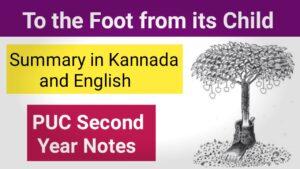
To the Foot from its Child summary in Kannada and English for Second PUC students. Kannada summary of the poem ‘To the Foot from its Child’ for class 2nd PUC.
In this post we have explained summary of the second PUC poem To the Foot from its Child. Kannada summary of To the Foot from its Child. English summary of To the Foot from its Child.
We have provided 2nd PUC English notes. Important notes for PUC second year exam. Important questions and answer for PUC second year.
To get more video notes for second PUC exam visit our YouTube channel. This channel is very useful for PUC second year exam preparation.
Kannada summary of ‘To the Foot from its Child’
To the Foot from its Child summary in Kannada:
ಪಾಬ್ಲೋ ನೆರುಡಾ ಅವರ ‘ಟು ದಿ ಫೂಟ್ ಫ್ರಂ ಇಟ್ಸ್ ಚೈಲ್ಡ್’, ಇದು ಮಗುವಿನ ಪಾದದ ಪ್ರಯಾಣವನ್ನು ವಯಸ್ಕ ಪಾದವಾಗುವವರೆಗೆ ಮತ್ತು ಅದು ಸಾಯುವವರೆಗೂ ವಿವರಿಸುತ್ತದೆ. ವಯಸ್ಕ ಪಾದವು ಸಾಯುವವರೆಗೂ ಅನುಭವಿಸಿದ ಅನುಭವಗಳನ್ನು ಹೇಳುವುದಲ್ಲದೆ, ಮಗುವಿನ ಪಾದವು ವಯಸ್ಕ ಪಾದವಾಗುವವರೆಗೆ ಆಗುವ ಬದಲಾವಣೆಗಳನ್ನು ಸಹ ಕವಿತೆ ವಿವರಿಸುತ್ತದೆ.
Central Idea of the poem:
ಕವಿಯು ಆರಂಭದಲ್ಲಿ ಮಗುವಿನ ಪಾದವು ನಡೆಯುತ್ತಿರುವುದು ಇನ್ನೂ ತಿಳಿದಿಲ್ಲ ಎಂದು ಉಲ್ಲೇಖಿಸುತ್ತಾನೆ. ಬದಲಿಗೆ, ಇದು ಚಿಟ್ಟೆ ಅಥವಾ ಸೇಬು ಆಗಬಹುದು ಎಂದು ಬಯಸುತ್ತದೆ. ಮಗು, ತನ್ನ ಗುರುತನ್ನು ಅರ್ಥಮಾಡಿಕೊಳ್ಳುವ ಮೊದಲು, ಆಕಾಂಕ್ಷೆಗಳು, ಕನಸುಗಳು ಮತ್ತು ಜೀವನದ ಸಂತೋಷವನ್ನು ಹೊಂದಿದೆ. ಮಗುವಿಗೆ ಚಿಟ್ಟೆ ಅಥವಾ ಸೇಬು ಆಗುವ ಮಹತ್ವಾಕಾಂಕ್ಷೆ ಇದೆ. ಆದರೆ ಕಾಲಾನಂತರದಲ್ಲಿ, ಕಲ್ಲುಗಳು ಮತ್ತು ಗಾಜಿನ ತುಂಡುಗಳು, ಬೀದಿಗಳು ಮತ್ತು ಏಣಿಗಳು, ಸಸ್ಯಗಳು ಮತ್ತು ಒರಟಾದ ಭೂಮಿಯು ಅದು ಹಾರಲು ಮತ್ತು ಹಣ್ಣಾಗಲು ಸಾಧ್ಯವಿಲ್ಲ ಎಂದು ಕಲಿಸುತ್ತದೆ.
ಆದರೆ ಮಗುವಿನ ಆಕಾಂಕ್ಷೆಗಳ ಕನಸುಗಳನ್ನು ಸಮಾಜವು ಬೆಂಬಲಿಸುವುದಿಲ್ಲ ಮತ್ತು ಪ್ರಪಂಚದ ಕತ್ತಲೆಯ ಮೂಲೆಗೆ ತಳ್ಳಲ್ಪಡುತ್ತದೆ, ಕತ್ತಲೆಯ ಜಗತ್ತಿನಲ್ಲಿ ಸೆರೆಯಾಳಾಗಿ ಬದುಕಲು ಬಂದಿಸಲ್ಪಟ್ಟ ಕಾಲು ತನ್ನ ಎಲ್ಲಾ ಕನಸುಗಳಿಂದ ಸಂಪೂರ್ಣವಾಗಿ ತೆಗೆದುಹಾಕಲ್ಪಟ್ಟಂತೆ. ಮಗು ಅನೇಕ ಬೀದಿಗಳು ಮತ್ತು ಏಣಿಗಳನ್ನು ದಾಟಬೇಕು, ಆದ್ದರಿಂದ ಹಣ್ಣು ಅಥವಾ ಚಿಟ್ಟೆಯಾಗುವುದು ಅಸಾಧ್ಯ. ಪಾದವನ್ನು ಶೂನಲ್ಲಿ ಬಂದಿಸಲಾಗುತ್ತದೆ. ಇಲ್ಲಿ ಶೂ ಎಂದರೆ ಅದು ಸಮಾಜದ ಸಂಕೋಲೆ, ಆದ್ದರಿಂದ ಅದನ್ನು ಅನುಭವಿಸುವುದು ಉಚಿತವಲ್ಲ.
ಪಾದರಕ್ಷೆಯಲ್ಲಿನ ಪಾದವು ಬೆಳೆಯುತ್ತದೆ ಮತ್ತು ಬದಲಾಗುತ್ತದೆ, ಕಾಲ್ಬೆರಳುಗಳು, ತ್ರಿಕೋನ ತಲೆಗಳು ಮತ್ತು ಹುಳುಗಳೊಂದಿಗೆ ಕಣ್ಣುಗಳಿಲ್ಲದ ಸರೀಸೃಪಗಳ ರೂಪವನ್ನು ತೆಗೆದುಕೊಳ್ಳುತ್ತವೆ. ಪಾದರಕ್ಷೆಯಲ್ಲಿ ಕಾಲು ಹೇಗೆ ಗಟ್ಟಿಯಾಗುತ್ತದೋ, ಅದರ ಆಕಾರವನ್ನು ಕಳೆದುಕೊಳ್ಳುತ್ತದೋ ಹಾಗೆಯೇ ಮಗುವೂ ತನ್ನೆಲ್ಲ ಮೃದುತ್ವವನ್ನು ಕಳೆದುಕೊಂಡು ಗಟ್ಟಿಯಾದ ವಯಸ್ಕನಾಗಿ ಬೆಳೆಯುತ್ತದೆ.
ತನ್ನ ಕನಸುಗಳಿಗೆ ಸಂಪೂರ್ಣವಾಗಿ ಅನ್ಯಲೋಕದ ಜಗತ್ತಿನಲ್ಲಿ ವಾಸಿಸುವ ವಯಸ್ಕನು ಬಿಡುವುವಿಲ್ಲದೆ ನಡೆಯುತ್ತಾನೆ ಮತ್ತು ಹೊಲಗಳು, ಗಣಿಗಳು, ಮಾರುಕಟ್ಟೆಗಳು ಮತ್ತು ಸಚಿವಾಲಯಗಳ ಮೂಲಕ ತನ್ನ ದಾರಿಯನ್ನು ಹಿಡಿಯುತ್ತಾನೆ. ಪ್ರೀತಿ, ನಿದ್ದೆ ಎರಡಕ್ಕೂ ಸಮಯ ಸಿಗದೆ ಪಾದರಕ್ಷೆಯಲ್ಲಿ ಕಾಲಿಟ್ಟಂತೆ ಜೀವನದಲ್ಲಿ ಶ್ರಮಿಸುತ್ತಾನೆ. ಅವನ ಜೀವನದ ನಡಿಗೆಯು ಹಿಂದಕ್ಕೆ, ಮುಂದಕ್ಕೆ, ದೂರದವರೆಗೆ ಮತ್ತು ಎಲ್ಲೆಡೆ ಮತ್ತು ಅಂತಿಮವಾಗಿ, ಅವನ ಜೀವನವು ನಿಲ್ಲುತ್ತದೆ. ಹೀಗೆ ಬಾಲ್ಯದಲ್ಲಿಯೇ ಬದುಕಬೇಕೆಂದು ಹಂಬಲಿಸಿದ ಬದುಕನ್ನು ಬದುಕುವ ಅವಕಾಶ ಸಿಗದೆ ಇಹಲೋಕ ತ್ಯಜಿಸುತ್ತಾನೆ.
Theme of the poem:
ಒಬ್ಬ ವ್ಯಕ್ತಿಯು ವಯಸ್ಕನಾಗುತ್ತಾನೆ ಮತ್ತು ನಿರಂತರ ಕೆಲಸ ಮತ್ತು ಹೋರಾಟದ ಜೀವನಕ್ಕೆ ಒಡ್ಡಿಕೊಂಡಾಗ ಬಾಲ್ಯದ ಸ್ವಾತಂತ್ರ್ಯವು ಕಳೆದುಹೋಗುತ್ತದೆ. ಹೊರಗೆ, ಅನಿಯಂತ್ರಿತ ಶಕ್ತಿಗಳು ಒಬ್ಬರ ಜೀವನವನ್ನು ನಿರ್ದೇಶಿಸುವ ಶಕ್ತಿಯನ್ನು ಹೊಂದಿವೆ ಮತ್ತು ಹೀಗಾಗಿ ಸಮಾಜದಲ್ಲಿ ‘ಜೀವನ’ ಜನರು ಸಾವಿನಿಂದ ಮತ್ತೆ ಮುಕ್ತರಾಗುವವರೆಗೆ ಅವರ ಮುಕ್ತ ಮನೋಭಾವವನ್ನು ಕಸಿದುಕೊಳ್ಳುತ್ತದೆ.
To the Foot from its Child summary
ಅಂಕಗಳು ಮತ್ತು ಪ್ರಶಸ್ತಿಗಳಿಂದ ಮಕ್ಕಳಿಗೆ ಹೊರೆಯಾಗುತ್ತಿದೆ ಎಂದು ನೆರುಡಾ ಸಮಾಜವನ್ನು ಟೀಕಿಸುತ್ತಾರೆ. ಮಗು ತನ್ನ ಬಾಲ್ಯವನ್ನು ಸಂತೋಷದಿಂದ ಕಳೆಯುವ ಬದಲು, ತನ್ನ ಭವಿಷ್ಯವನ್ನು ರೂಪಿಸಲು ಉತ್ತಮ ಅಂಕಗಳನ್ನು ಪಡೆಯಲು ತುಂಬಾ ಶ್ರಮಿಸುತ್ತದೆ. ಸಮಾಜವು ತನ್ನ ಇಚ್ಛೆಗೆ ಅನುಗುಣವಾಗಿ ಮಗುವನ್ನು ಬಿಡುವುದಿಲ್ಲ ಆದರೆ ಸಮಾಜದ ಬಂಧಗಳನ್ನು ಕಟ್ಟುತ್ತದೆ ಮತ್ತು ಸಮಾಜದ ಆಶಯದಂತೆ ಅದನ್ನು ದಾರಿಯಲ್ಲಿ ಸಾಗುವಂತೆ ಮಾಡುತ್ತದೆ.
To the Foot from its Child summary in English:
‘To the Foot from its Child’ by Pablo Neruda, which narrates the journey of a child’s foot until it becomes an adult foot and beyond until it dies. Besides narrating the experiences of the adult foot until its death, the poem also describes the changes that the child’s foot undergoes until it becomes an adult foot.
Central Idea of the poem:
The poet initially mentions that the child’s foot is not yet aware it’s afoot. Instead, it would like to be a butterfly or an apple. The child, even before understanding its identity, has aspirations and dreams and the joy of living. The child has the ambition to become either a butterfly or an apple. But in time, stones, and pieces of glasses, streets, and ladders, the plants, and the rough earth teach that it cannot fly and be a fruit.
But the child’s dreams of aspirations are not supported by society and are pushed into a dark corner of the world, just like a foot that is condemned to live in a shoe as a prisoner in a dark world totally removed from all its dreams. The child has to cross many streets and ladders, so becoming a fruit or a butterfly is impossible. The foot is condemned to live in a shoe. Here a shoe means it is covered by society, so it is not free to enjoy.
English summary of To the Foot from its Child
The foot in the shoe grows hand and changes, with the toes taking the form of eyeless reptiles with triangular heads & worms. Just like how the foot in a shoe ends up becoming hard, loses its shape, the child too loses all its softness and grows up as a hardened adult.
The adult living in a totally alien world to his dreams walks on and on without respite, groping his way through fields, mines, markets, and ministries. He toils in life just like a foot in a shoe without finding time for either love or sleep. His walk of life includes walking backward, forward, far afield, and everywhere and finally, his life stops. Thus, he departs from this world without getting a chance to live the life that he has aspired to live even as a child.
Theme of the poem:
The freedom of childhood is lost when a person becomes an adult and is exposed to a life of constant work and struggle. Outside, uncontrollable forces have the power to direct one’s life and thus ‘life’ in society takes away people’s free spirits until they are freed again by death.
Neruda criticizes society for burdening the children with marks and awards. Instead of spending its childhood happily, the child works very hard to get good marks to shape its future. Society does not leave the child according to its will and wish but ties the bonds of society and makes it move along a path according to society’s wish.
Watch this video for the explanation of To the Foot from its Child summary in Kannada and English for Second PUC students.
